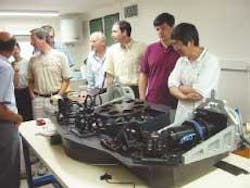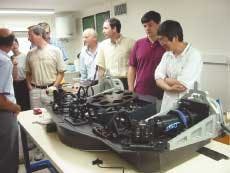Supernova spectrograph achieves first light
Mounted on the University of Hawaii's 2.2-m telescope atop Mauna Kea on the island of Hawaii, the Supernova Integral Field Spectrograph (SNIFS), achieved first light in June (see figure). Analysis of the initial data combined with a separate observation has confirmed that design goals were being met. The instrument was designed to observe Type Ia supernovae by simultaneously obtaining more than 200 spectra of each target, its home galaxy, and the nearby night sky. It is also one element in the international Nearby Supernova Factory (SNfactory), initiated at the Lawrence Berkeley National Laboratory (LBNL; Berkeley, CA). The SNfactory's goal is to find and study more than 300 nearby Type Ia supernovae.
"Type Ia supernovae are the key to understanding the mysterious dark energy that's causing the universe to expand ever faster," said astronomer Greg Aldering of Berkeley Lab's Physics Division, who leads the SNfactory collaboration. The new instrument acquired its first astronomical target, a Type Ia supernova designated SN 2004ca, in the constellation Cygnus (the Swan) on June 8. This was followed by the observation on June 20 of SN 2004cr in the constellation Cepheus (the King).
The SNIFS produces a spectrum at each position within a 6 × 6-arcsecond region around the target supernova, including its home galaxy and surrounding sky, using an integral field unit consisting of an array of individual lenslets. Light is extracted from the telescope's field of view by a small prism and directed to either blue- or red-sensitive 8-megapixel astronomical CCD cameras. Together these cameras collect all the optical light from each supernova.
A separate photometry camera running in parallel with the spectrograph under identical observation conditions allows spectra to be corrected for variables like thin cloud cover. A guide camera keeps the spectrograph precisely aligned on target by measuring the position of a guide star within the telescope's wider field of view once each second, adjusting the aim if necessary.
Precise detail
A SNIFS measurement provides enough spectrographic and photometric detail to determine a given Type Ia's specific physical characteristics including, for example, whether or not it is unusually energetic or how much its light may have been dimmed by dust in its home galaxy. This makes it possible to take advantage of a unique characteristic of Type Ia supernovae. "They can be calibrated individually, not simply statistically," Aldering said. "We'll be able to measure the luminosity with confidence. Knowing the luminosity, we can tell you the distance with precision."
The SNfactory strategy has two pipelines, the first being a supernova search using automated wide-field sky surveys. Data are provided by the QUEST-II 160-megapixel camera, built by Yale University (New Haven, CT) and Indiana University (Bloomington, IN) and operated at Palomar Observatory (San Diego, CA) by the QUEST-II group, as well as by the Jet Propulsion Laboratory's Near Earth Asteroid Tracking team and the California Institute of Technology (Pasadena, CA). The data are transmitted by the High-Performance Research and Education Network to the National Energy Research Scientific Computing Center (NERSC) at LBNL for identification of likely supernova candidates.
The ideal study candidate is a recently exploded Type Ia supernova that is near enough for accurate measurement of its spectrum and light curve (rising and falling brightness) but far enough away to be in the so-called "smooth Hubble flow," meaning that its redshift arises mostly from the expansion of the universe alone, unaffected by the motion of its home galaxy through space. The SNfactory's search phase has been operating for more than a year, although not at full capacity. "The search will now be going full steam," Aldering said. "We'll be getting a few candidates each night of the year—more than the entire current worldwide rate of discovery."
The second SNfactory pipeline passes the search candidates on to SNIFS, where the type and redshift of each supernova are determined and the most promising are selected and scheduled for more detailed study. The SNfactory uses the University of Hawaii's telescope three times a week for half a night—the half beginning at midnight, as a courtesy to local observers—with SNIFS available to other projects at other times.

